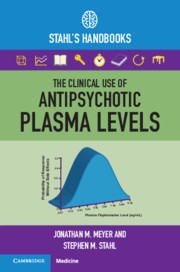Book contents
- The Clinical Use of Antipsychotic Plasma Levels
- Reviews
- The Clinical Use of Antipsychotic Plasma Levels
- Copyright page
- Half title page
- Contents
- Foreword
- Preface: How to Use This Handbook and Useful Tables for Handy Reference
- Introduction
- 1 Sampling Times for Oral and Long-Acting Injectable Agents
- 2 The Therapeutic Threshold and the Point of Futility
- 3 Level Interpretation Including Laboratory Reporting Issues, Responding to High Plasma Levels, Special Situations (Hepatic Dysfunction, Renal Dysfunction and Hemodialysis, Bariatric Surgery)
- 4 Tracking Oral Antipsychotic Adherence
- 5 What Is an Adequate Antipsychotic Trial? Using Plasma Levels to Optimize Psychiatric Response and Tolerability
- 6 Important Concepts about First-Generation Antipsychotics
- 7 Haloperidol and Haloperidol Decanoate
- 8 Fluphenazine and Fluphenazine Decanoate
- 9 Perphenazine and Perphenazine Decanoate
- 10 Zuclopenthixol and Zuclopenthixol Decanoate; Flupenthixol and Flupenthixol Decanoate
- 11 Chlorpromazine, Loxapine, Thiothixene, Trifluoperazine
- 12 Important Concepts about Second-Generation Antipsychotics
- 13 Clozapine
- 14 Risperidone Oral and Long-Acting Injectable; Paliperidone Oral and Long-Acting Injectable
- 15 Olanzapine and Olanzapine Pamoate
- 16 Aripiprazole, Aripiprazole Monohydrate, and Aripiprazole Lauroxil
- 17 Amisulpride, Asenapine, Lurasidone, Brexpiprazole, Cariprazine
- Appendix Therapeutic Threshold, Point of Futility, AGNP/ASCP Laboratory Alert Level, and Average Oral Concentration–Dose Relationships
- Index
- References
1 - Sampling Times for Oral and Long-Acting Injectable Agents
Published online by Cambridge University Press: 19 October 2021
- The Clinical Use of Antipsychotic Plasma Levels
- Reviews
- The Clinical Use of Antipsychotic Plasma Levels
- Copyright page
- Half title page
- Contents
- Foreword
- Preface: How to Use This Handbook and Useful Tables for Handy Reference
- Introduction
- 1 Sampling Times for Oral and Long-Acting Injectable Agents
- 2 The Therapeutic Threshold and the Point of Futility
- 3 Level Interpretation Including Laboratory Reporting Issues, Responding to High Plasma Levels, Special Situations (Hepatic Dysfunction, Renal Dysfunction and Hemodialysis, Bariatric Surgery)
- 4 Tracking Oral Antipsychotic Adherence
- 5 What Is an Adequate Antipsychotic Trial? Using Plasma Levels to Optimize Psychiatric Response and Tolerability
- 6 Important Concepts about First-Generation Antipsychotics
- 7 Haloperidol and Haloperidol Decanoate
- 8 Fluphenazine and Fluphenazine Decanoate
- 9 Perphenazine and Perphenazine Decanoate
- 10 Zuclopenthixol and Zuclopenthixol Decanoate; Flupenthixol and Flupenthixol Decanoate
- 11 Chlorpromazine, Loxapine, Thiothixene, Trifluoperazine
- 12 Important Concepts about Second-Generation Antipsychotics
- 13 Clozapine
- 14 Risperidone Oral and Long-Acting Injectable; Paliperidone Oral and Long-Acting Injectable
- 15 Olanzapine and Olanzapine Pamoate
- 16 Aripiprazole, Aripiprazole Monohydrate, and Aripiprazole Lauroxil
- 17 Amisulpride, Asenapine, Lurasidone, Brexpiprazole, Cariprazine
- Appendix Therapeutic Threshold, Point of Futility, AGNP/ASCP Laboratory Alert Level, and Average Oral Concentration–Dose Relationships
- Index
- References
Summary
The use of antipsychotics to treat schizophrenia is fraught with many layers of complexity as prescribers try to tailor the pharmacodynamic properties of an agent to a specific patient based primarily on subjective response. Variations in drug metabolism related to genetic polymorphisms, or to medication or environmental exposures (e.g. smoking), and variable adherence with oral medications lead to scenarios that confound even seasoned clinicians. Excluding the realization that up to one-third of schizophrenia patients may not respond adequately to non-clozapine antipsychotics, 60 years of antipsychotic research has demonstrated that dose is a poor correlate of response likelihood, whereas plasma drug levels represent the best clinically available tool that quantifies the relationship between drug exposure and central nervous system (CNS) activity [1].
- Type
- Chapter
- Information
- The Clinical Use of Antipsychotic Plasma LevelsStahl's Handbooks, pp. 13 - 33Publisher: Cambridge University PressPrint publication year: 2021



